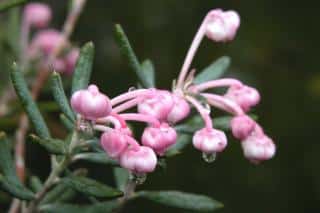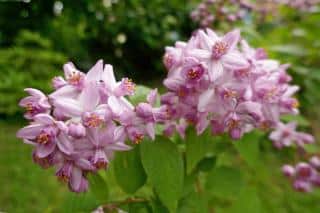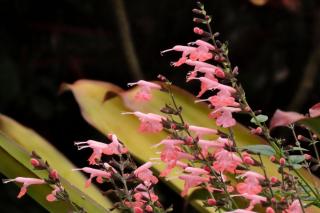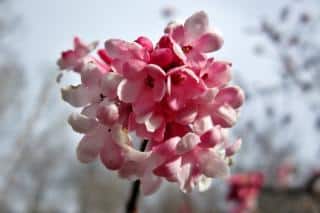

From Spring to Winter, dress your garden in lovely pink blooms. To decorate your terrace, turn your hedge into a wonderful wall of color, or brighten up the back of a shrub bed, here is our selection of striking pink-blooming shrubs!
Read also:
The blooming of this Cornus shrub is an experience for everyone. Four tall bracts emerge, pale pink with a dramatic deep pink lining. Lanceolate leaves boast marked veins, and the somewhat commonplace green gives way to flamboyant fire-like colors in Fall. As a dense shrub, whether as a standalone or a hedge, this dogwood can grow 10 feet tall and 6 feet wide (3 meters tall by 2 wide). It prefers either full sun or part shade. A lover of well drained soil, it does best when the ground is cool and even a bit acidic. It won’t like chalky, alkaline soil.


This crazy Caryopteris species doesn’t follow the flock: though its common name is “bluebeard”, you can’t deny that the blooming here is a clear, resounding pink! Flowering runs from July to September, beautiful spheres of simple soft pink flowers. The long pink stamens lend the bush a hazy, dreamy look. It forms a dense 3-foot tall bush (1m), and the fragrant deep green leaves drop to the ground during Winter. Their shape is that of a narrow, serrated triangle. Caryopteris revels in sunny locations in soil that has excellent drainage, even if it gets bone-dry at times. Ideal for a hedge, shrub beds, and even as a waist-size feature in rocky terrain.

This strawberry tree won’t give you many flowers during Summer, but it’ll treat you to a true full tree of autumn blooms from September to November. Each flower is like a tiny pink bell, and sits next to the round fruits of the previous years’ blooming. The fruits are what gave the tree its name: yellow at first, shifting to red with a granular, pocked surface explain why it’s called the “strawberry tree”. Lanceolate shiny deep green leaves give the tree a pleasant volume all year round. Resistant to the cold down to 15°F (about -10°C), this shrub grows into a tight, dense shrub that will fit right into any hedge or shrub bed. In cooler regions, you’re better off growing it in pots set in spots that don’t have any wind. The strawberry tree prefers well draining soil, rocks aren’t a problem at all. As for the pH, it favors lightly acidic soil. It’ll easily settle down into most gardens as long as the soil drains well. Plant it where you want it: sun or shade suit it equally well.

In the vast Camellia family, several species bloom during Winter. That’s exactly the case for the ‘Sunny Side’ camellia, for which flowers appear between December and February. Renowned for its abundant blooming, massive amounts of simple flowers open up, with cool pastel pink centers and darker, starker hues around the periphery. At the center of the flower, a small bouquet of golden yellow stamens highlight the rich pink tones. As for most Camellia species, leafage stays on the tree year-round: oval, lightly serrated leaves that are shiny and deep green. Never growing any taller than 4 feet (1.2m) for a width of 3 feet (1m), it’s perfect for heath plant flower beds or in a large pot on your terrace. This pink-blooming shrub can take the cold up to 5°F or -15°C, but it’s vulnerable to wind and snow. An important planting tip is to favor acidic soil that is rich and drains very well. Part shade is fine.